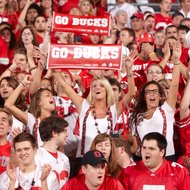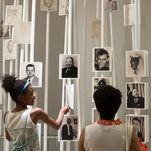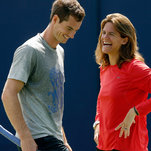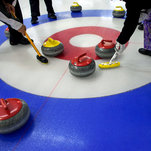IT was a great day to be a Buckeye. Josh Samuels, a junior from Cincinnati, dates his decision to attend Ohio State to Nov. 10, 2007, and the chill he felt when the band took the field during a football game against Illinois. “I looked over at my brother and I said, ‘I’m going here. There is nowhere else I’d rather be.’ ” (Even though Illinois won, 28-21.)
How Big-Time Sports Ate College Life
By LAURA PAPPANO
Published: January 20, 2012
Damian Strohmeyer/Sports Illustrated/Getty Images
BUCKEYE NATION Unbridled enthusiasm reigns at Ohio State games.
Multimedia
Sporting News, via Getty Images
K-VILLE This is not Occupy Duke. It's annual tenting outside Cameron Indoor Stadium for the best seats at a basketball game.
Tim Collins, a junior who is president of Block O, the 2,500-member student fan organization, understands the rush. “It’s not something I usually admit to, that I applied to Ohio State 60 percent for the sports. But the more I do tell that to people, they’ll say it’s a big reason why they came, too.”
Ohio State boasts 17 members of the American Academy of Arts and Sciences, three Nobel laureates, eight Pulitzer Prize winners, 35 Guggenheim Fellows and a MacArthur winner. But sports rule.
“It’s not, ‘Oh, yeah, Ohio State, that wonderful physics department.’ It’s football,” said Gordon Aubrecht, an Ohio State physics professor.
Last month, Ohio State hired Urban Meyer to coach football for $4 million a year plus bonuses (playing in the B.C.S. National Championship game nets him an extra $250,000; a graduation rate over 80 percent would be worth $150,000). He has personal use of a private jet.
Dr. Aubrecht says he doesn’t have enough money in his own budget to cover attendance at conferences. “From a business perspective,” he can see why Coach Meyer was hired, but he calls the package just more evidence that the “tail is wagging the dog.”
Dr. Aubrecht is not just another cranky tenured professor. Hand-wringing seems to be universal these days over big-time sports, specifically football and men’s basketball. Sounding much like his colleague, James J. Duderstadt, former president of the University of Michigan and author of “Intercollegiate Athletics and the American University,” said this: “Nine of 10 people don’t understand what you are saying when you talk about research universities. But you say ‘Michigan’ and they understand those striped helmets running under the banner.”
For good or ill, big-time sports has become the public face of the university, the brand that admissions offices sell, a public-relations machine thanks to ESPN exposure. At the same time, it has not been a good year for college athletics. Child abuse charges against a former Penn State assistant football coach brought down the program’s legendary head coach and the university’s president. Not long after, allegations of abuse came to light against an assistant basketball coach at Syracuse University. Combine that with the scandals over boosters showering players with cash and perks at Ohio State and, allegedly, the University of Miami and a glaring power gap becomes apparent between the programs and the institutions that house them.
“There is certainly a national conversation going on now that I can’t ever recall taking place,” said William E. Kirwan, chancellor of the University of Maryland system and co-director of the Knight Commission on Intercollegiate Athletics. “We’ve reached a point where big-time intercollegiate athletics is undermining the integrity of our institutions, diverting presidents and institutions from their main purpose.”
The damage to reputation was clear in a November survey by Widmeyer Communications in which 83 percent of 1,000 respondents blamed the “culture of big money” in college sports for Penn State officials’ failure to report suspected child abuse to local law enforcement; 40 percent said they would discourage their child from choosing a Division I institution “that places a strong emphasis on sports,” and 72 percent said Division I sports has “too much influence over college life.”
Has big-time sports hijacked the American campus? The word today is “balance,” and the worry is how to achieve it.
This article has been revised to reflect the following correction:
Correction: January 29, 2012
An article last Sunday about the effect of big-time sports on college life misstated part of the name of an honor society that has 17 members from Ohio State. It is the American Academy of Arts and Sciences, not the National Academy of Arts and Sciences.












